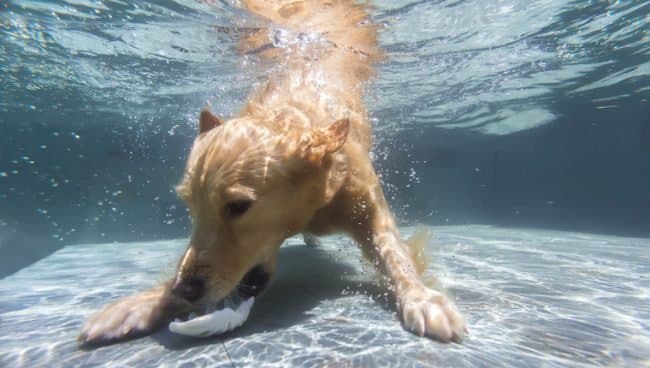[ad_1]

(Photo Credit: Konstantin Trubavin/Aurora Photos/Getty)
Ever wondered if dogs can hold their breath underwater and for how long? Or how deep can they dive?
Like other non-aquatic mammals, dogs can hold their breath underwater. And dogs are born that way — they can instinctively hold their breath underwater due to a natural reflex that kicks in. It’s called the mammalian diving response. The mammalian diving reflex is a unique set of evolutionary adaptations leftover from a time when all life developed in the oceans, explains Interia, which applies to humans and dogs. Immediately upon facial contact with water, a reduction of the heart rate (bradycardia) by approximately 10-25 percent occurs. The heartbeat slows down to reduce the body’s need for oxygen. Once below the surface, a dog’s windpipe automatically closes so that no water gets into the lungs, and breathing stops. As well, a canine’s heartbeat slows down to reduce the body’s need for oxygen.
Dogs can only hold their breath for an average of 5-10 seconds, according to TAG24. Dogs with short noses typically lean towards the former range while longer snout breeds, combined with long legs, “webbed” paws, and a larger lung volume can stay underwater longer.
Diving Dogs
How deep dogs can dive depends on the breed.
While some dogs take to diving like a duck to water, others are pretty much landlubbers. Dogs typically dive as deep as 6-7 feet, which isn’t that deep compared to humans who can dive (untrained) up to about 20 feet. Depending on their breed and training, however, some dogs can swim to depths as deep as 15 feet. Local 10 News in Boca Raton, Florida featured two Labrador Retrievers trained to dive for lobsters. “It was very difficult. It took me about two years to train them fully to catch lobsters. The hardest part for the dogs was to train them to use their back legs and get their momentum to go down,” said pet parent Alex Schulze.
Motivation is key. For instance, Retrievers — whose favorite pastime is fetching an object — are more likely to want to dive into the pool than a non-water dog such as a Pug.
According to TAG24, dogs that are good at diving include:
Landlubbers typically have short legs, an elongated body, and a short neck. Dogs with shorter noses have always had difficulty breathing and therefore have trouble holding their breath. They also have more difficulty breathing than bigger dogs and are less capable of paddling. These breeds include:
Water and Diving Safety
The National Canine Research Association of America (NCRAOA) notes that not all dogs can swim well underwater, and some could drown if left underwater for long. For instance, Pugs and Basset Hounds don’t have the lung capacity to help them stay underwater for long, and they generally have low amounts of oxygen in their body tissues, limiting the time they can stay underwater.
Dogs with large lung capacities can dive further underwater, according to the NCRAOA. With the exception of the Newfoundland breed, which retains its lung size even in old age, the size of lungs decreases with age.
Whatever the breed, and even if your dog is good at diving, that doesn’t mean they’re always in control, so keep in close contact with your pup when you’re splashing about.
[ad_2]
Source link




Leave a Comment